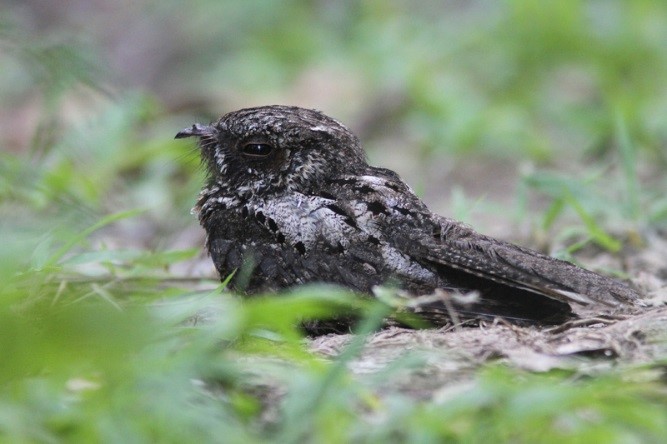Birdfinding.info ⇒ Widely distributed across Cuba, but uncommon and local overall. It seems to be most readily found in the Zapata Swamp region, especially at Playa Larga, Soplillar, and Bermejas. Other areas where it can generally be found include Cayo Coco and the vicinity of Guardalavaca in Holguín.
Cuban Nightjar
Antrostomus cubanensis
Endemic to Cuba and its satellites, including the Isle of Youth and the Jardines del Rey Archipelago, where it inhabits various types of woodlands. Occurs at all elevations, but seems to be most numerous in humid lowlands. Apparently much less numerous in the southeast.
Identification
A medium-large, blackish-brown nightjar with an extensive white or cream-colored tail-tip visible from below and conspicuous gray straps on the back.
Male’s uppertail has small white corner patches. Female’s uppertail has buffy corners that are rarely visible when the tail is folded.

Cuban Nightjar, male showing white corners on uppertail and gray straps on the back. (Soplillar, Matanzas, Cuba; February 23, 2015.) © Knut Hansen
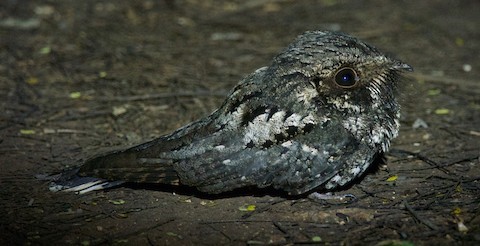
Cuban Nightjar, male showing white corners on uppertail and gray straps on the back. (Soplillar, Matanzas, Cuba; February 22, 2015.) © Clayton Burne

Cuban Nightjar, male showing little of the gray straps on its back in this view. (Cayo Coco, Cuba; March 8, 2017.) © Timo Mitzen

Cuban Nightjar, showing cold-brown and gray coloration. (Bermejas Wildlife Refuge, Matanzas, Cuba; April 23, 2017.) © Dave Wendelken
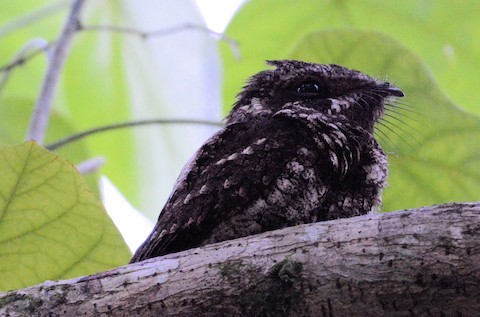
Cuban Nightjar, showing blackish overall coloration. (La Turba, Matanzas, Cuba; April 9, 2018.) © Kenneth Butler
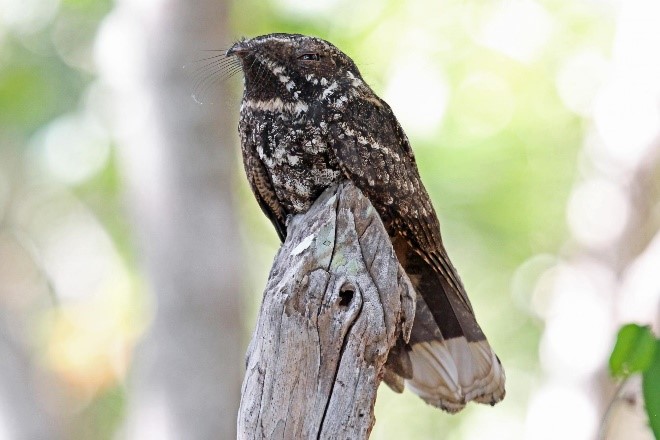
Cuban Nightjar, male showing the extent of white on the tip of its undertail. (Soplillar, Matanzas, Cuba; April 6, 2014.) © Greg Griffith
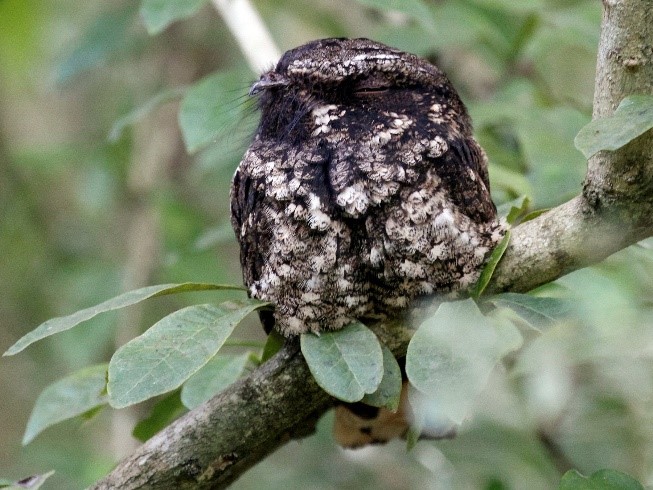
Cuban Nightjar, showing extensive pale mottling on the breast. (Soplillar, Matanzas, Cuba; February 23, 2015.) © Peter Kennerley
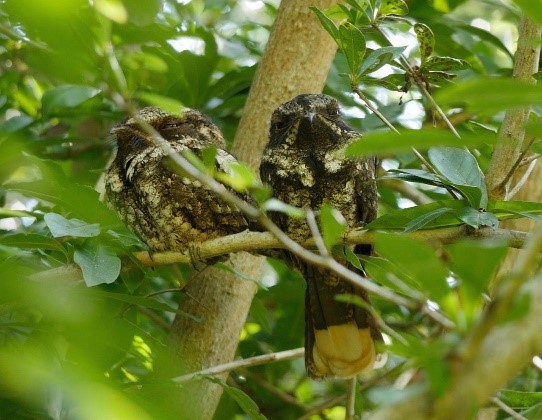
Cuban Nightjar, pair showing the extent of pale undertail tip. (Soplillar, Matanzas, Cuba; January 16, 2017.) © Greg Baker
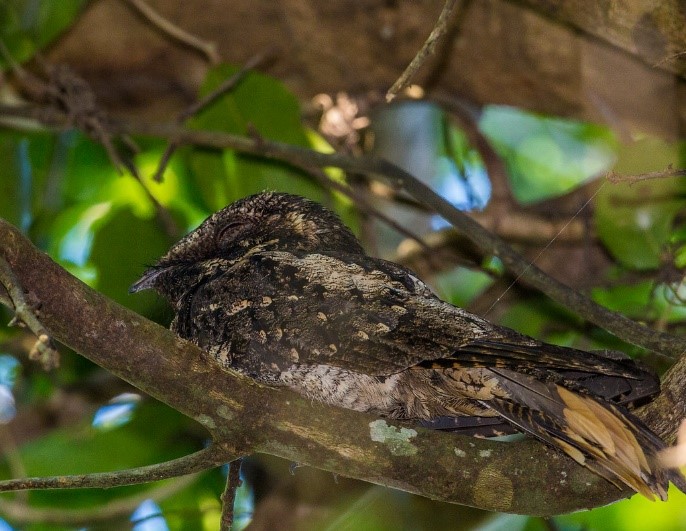
Cuban Nightjar, female showing buffy undertail tip. (Playa Larga, Matanzas, Cuba; December 5, 2016.) © NigelJE

Cuban Nightjar, female, showing broad gray straps on the back. (Soroa, Artemisa, Cuba; May 17, 2007.) © peterbateup
Cf. Chuck-will’s-widow. From September to May, Cuban Nightjar shares its range with non-breeding Chuck-will’s-widow, which is very similar but somewhat larger and usually a paler, warmer shade of brown overall. Cuban can often be recognized by the pale gray straps on its back. Male Cuban can also be identified by the white corner patches on its uppertail, whereas male Chuck-will’s-widow has white only on the inner webs of its outer tail feathers—so its uppertail looks either unmarked (when closed) or partly striped (when spread).
Cf. Eastern Whip-poor-will. The Eastern Whip-poor-will has been recorded on Cuba and seems likely to occur regularly in winter. It is very similar to the Cuban Nightjar, including the pale straps on the back. If encountered in daylight, the two species would normally be distinguishable by the overall tones of their plumage: Cuban being a cold, blackish-brown, and the Whip-poor-will usually warm-brown. The male Whip-poor-will typically has much more extensive white on the outer tail feathers, visible mainly on the underside of the tail.
Notes
Polytypic species consisting of two recognized subspecies. Formerly considered conspecific with Hispaniolan Nightjar (A. ekmani), together known as the Greater Antillean Nightjar (A. cubanensis), but they differ noticeably in vocalizations and tail pattern.
References
BirdLife International. 2018. Antrostomus cubanensis. The IUCN Red List of Threatened Species 2018: e.T22689786A130167550. https://www.iucnredlist.org/species/22689786/130167550. (Accessed October 28, 2019.)
Cleere, N. 2019. Cuban Nightjar (Antrostomus cubanensis). In Handbook of the Birds of the World Alive (J. del Hoyo, A. Elliott, J. Sargatal, D.A. Christie, and E. de Juana, eds.). Lynx Edicions, Barcelona. https://www.hbw.com/node/55187. (Accessed October 28, 2019.)
Cleere, N., and D. Nurney. 1998. Nightjars: A Guide to Nightjars and Related Nightbirds. Pica Press, Sussex.
eBird. 2019. eBird: An online database of bird distribution and abundance. Cornell Lab of Ornithology, Ithaca, N.Y. http://www.ebird.org. (Accessed October 28, 2019.)
Garrido, O.H, and A. Kirkconnell. 2000. Field Guide to the Birds of Cuba. Cornell University Press, Ithaca, N.Y.
Holyoak, D.T. 2001. Nightjars and Their Allies. Oxford University Press.
Raffaele, H., J. Wiley, O. Garrido, A. Keith, and J. Raffaele. 1998. A Guide to the Birds of the West Indies. Princeton University Press, Princeton, N.J.
Weber, D. 2014. Greater Antillean Nightjar (Antrostomus cubanensis), version 1.0. In Neotropical Birds Online (T.S. Schulenberg, ed.). Cornell Lab of Ornithology, Ithaca, N.Y. https://doi.org/10.2173/nb.granig1.01.
